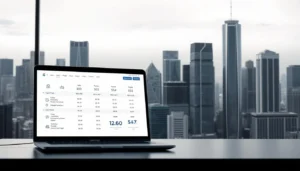Last Updated on: June 19, 2025
In today’s digital landscape, having a professional online presence is crucial for small businesses to attract and retain customers.
A well-designed website can be a game-changer, but choosing the right web design services can be daunting.
With numerous web design services available, small businesses must consider several factors to ensure they partner with a provider that understands their unique needs and goals.
Key Takeaways
- Understand your business needs and goals.
- Research potential web design service providers.
- Evaluate portfolios and client testimonials.
- Consider the importance of mobile responsiveness.
- Assess the provider’s expertise in SEO.
The Impact of Professional Web Design on Small Business Success
Professional web design plays a pivotal role in determining the success of small businesses in the competitive digital marketplace. A well-designed website not only enhances the online presence of a business but also significantly influences its credibility and customer engagement.
First Impressions and Brand Credibility
The first impression a potential customer gets from a website can make or break a business. A professional web design ensures that this first impression is positive, conveying a sense of professionalism and reliability. According to a study, 75% of users judge a company’s credibility based on its website. Thus, investing in professional web design is crucial for establishing brand credibility.
“A well-designed website is the cornerstone of a company’s digital presence, influencing how customers perceive the brand.”
Forbes
Conversion Rates and Customer Engagement
A professionally designed website is optimized for user experience, which directly impacts conversion rates and customer engagement. By incorporating intuitive navigation, clear calls-to-action, and responsive design, businesses can significantly enhance their website’s performance. Studies have shown that a well-designed website can increase conversion rates by up to 200%.
Competitive Advantage in the Digital Marketplace
In a crowded digital marketplace, a professional web design can be a key differentiator for small businesses. By showcasing a brand’s unique value proposition and providing a seamless user experience, businesses can stand out from their competitors. A table comparing the features of professional and amateur web designs highlights this difference:
By investing in professional web design, small businesses can not only enhance their online presence but also gain a competitive edge in the digital marketplace.
Assessing Your Small Business Website Needs
The journey to a successful business website begins with a thorough assessment of your business needs. Understanding your requirements is crucial in making informed decisions when selecting web design services.
Defining Your Business Goals and Objectives
To create an effective website, you must first define your business goals and objectives. This involves determining what you want to achieve with your website.
Sales vs. Information-Focused Websites
Your website can either be sales-focused, designed to drive conversions and sales, or information-focused, aimed at providing valuable content to your audience. Choosing the right approach depends on your business model and goals.
Measuring Success Metrics
Identifying how you will measure the success of your website is vital. This could include metrics such as website traffic, engagement rates, or conversion rates. Setting clear metrics helps in evaluating the effectiveness of your website.
Identifying Your Target Audience
Understanding your target audience is key to creating a website that resonates with them. This involves analyzing demographics, preferences, and behaviors to tailor your content and design accordingly.
Content and Functionality Requirements
Determining the content and functionality requirements of your website is essential. This includes deciding on the type of content, features, and interactive elements that will engage your audience and support your business goals.
By carefully assessing your business needs, you can ensure that your website is designed to meet your objectives and effectively serve your target audience.
Types of Web Design Services Available for Small Businesses
Small businesses have a variety of web design services to choose from, each with its unique benefits and drawbacks. Understanding these options is crucial for making an informed decision that aligns with their business goals and budget.
Custom Web Design vs. Template-Based Solutions
Custom web design offers a tailored approach, creating a unique online presence that reflects the brand’s identity. On the other hand, template-based solutions provide a cost-effective and quicker way to establish an online presence, though with less uniqueness.
Key considerations for custom web design include:
- Unique branding and identity
- Flexibility in design and functionality
- Scalability for future growth
Template-based solutions are ideal for:
- Businesses on a tight budget
- Those needing a quick online presence
- Simple website requirements
Full-Service Agencies vs. Freelance Designers
Full-service agencies offer a comprehensive range of services, from design to development and marketing. Freelance designers, while potentially more cost-effective, may offer specialized skills but with less breadth of service.
Benefits of full-service agencies:
- One-stop-shop for all web needs
- Integrated services for cohesive branding
- Account management for streamlined communication
Freelance designers are suitable for:
- Projects with specific, specialized needs
- Smaller budgets
- Personalized, direct communication
Local vs. Remote Web Design Providers
The choice between local and remote web design providers depends on the business’s needs for face-to-face interaction, project complexity, and budget considerations.
Local providers offer:
- Face-to-face meetings and direct communication
- Local market knowledge and insights
- Potential for ongoing support
Remote providers are advantageous for:
- Access to a broader talent pool
- Potentially lower costs
- Flexibility in project management and timelines
How to Choose Web Design Services for a Small Business?
The process of choosing a web design service is pivotal for small businesses looking to make a mark in the digital landscape. With numerous options available, it’s essential to have a clear understanding of what to look for in a web design service provider.
Researching Potential Providers
Begin by researching potential web design service providers. Look for companies or individuals with a strong online presence and positive reviews. Utilize search engines, social media, and professional networks like LinkedIn to find potential candidates.
Key factors to consider during your research include:
- Experience in handling projects similar to yours
- Expertise in the latest web design trends and technologies
- Client testimonials and case studies
Evaluating Portfolios and Past Work
Once you have a list of potential providers, evaluate their portfolios and past work. This step is crucial in understanding their design style, quality of work, and ability to deliver projects that meet client expectations.
Industry-Specific Experience
It’s beneficial to choose a web design service with experience in your industry. They will have a better understanding of your target audience and the specific challenges you face.
Design Style Compatibility
Ensure that the design style of the provider aligns with your brand identity. Review their past projects to gauge their ability to create designs that resonate with your vision.
Reading Client Testimonials and Reviews
Client testimonials and reviews provide valuable insights into the reliability and professionalism of a web design service. Look for reviews on independent platforms and ask for references to get a well-rounded view of their services.
By carefully researching potential providers, evaluating their portfolios, and reading client testimonials, you can make an informed decision when choosing a web design service for your small business.
Budget Considerations for Small Business Web Design
When it comes to web design for small businesses, budget is a critical factor that can significantly impact the success of the project. A well-planned budget ensures that the website meets the business’s needs and provides a good return on investment (ROI).
Pricing Models Explained
Web design agencies use various pricing models, including fixed-price, hourly-rate, and retainer-based models. Understanding these models is crucial for small businesses to manage their web design budget effectively. For instance, a fixed-price model can provide cost certainty, while an hourly-rate model may offer flexibility.
Potential Hidden Costs
Small businesses should be aware of potential hidden costs associated with web design, such as costs for content creation, image licensing, and ongoing maintenance. These costs can add up quickly, so it’s essential to factor them into the overall budget.
“A well-designed website is not just about aesthetics; it’s about creating a digital experience that drives business results.”
Unknown
Balancing Cost and Quality
To achieve a balance between cost and quality, small businesses should prioritize their needs and allocate their budget accordingly. It’s also crucial to consider the ROI of the website and ensure that the design and functionality align with the business’s goals.
By understanding pricing models, being aware of hidden costs, and balancing cost with quality, small businesses can create a website that meets their needs and provides a strong ROI.
Essential Questions to Ask Web Design Service Providers
When selecting a web design service provider, it’s crucial to ask the right questions to ensure you find the best fit for your small business needs. A well-prepared list of questions can help you assess the provider’s capabilities, understand their process, and determine whether they can meet your expectations.
Experience and Expertise Questions
To gauge the experience and expertise of a web design service provider, you should ask questions like: What experience do you have in designing websites for small businesses in our industry? Can you share examples of your previous work and the challenges you faced? What technologies and tools do you use for web design and development?
Asking these questions will help you understand their level of expertise and whether they have the necessary skills to deliver a high-quality website that meets your business needs.
Process and Timeline Questions
Understanding the web design process and timeline is vital to ensure that your project is completed on time and within budget. Ask questions like: What is your design and development process? How long will it take to complete the project? What are the milestones and deadlines? How do you handle revisions and changes?
Process and Timeline
Support and Maintenance Questions
After the website is launched, it’s essential to understand the support and maintenance services offered by the provider. Ask questions like: What kind of support do you offer after the website is launched? How do you handle updates and maintenance? What are the costs associated with ongoing support and maintenance?
By asking these questions, you can ensure that your website remains secure, up-to-date, and continues to meet your business needs over time.
Red Flags to Avoid When Selecting Web Design Services
When searching for web design services, it’s crucial to be aware of potential red flags that could indicate a problematic provider. A well-informed decision can save small businesses from costly mistakes and ensure a successful online presence.
Unrealistic Promises and Guarantees
One major red flag is when a web design service makes unrealistic promises or guarantees. Claims of achieving a #1 search engine ranking overnight or guaranteeing a certain amount of traffic are unrealistic and often indicative of a lack of understanding or integrity. Legitimate web design services focus on creating a solid foundation for your website and providing realistic expectations.
Poor Communication and Responsiveness
Poor communication and responsiveness are significant indicators of potential issues. A reliable web design service should be prompt in their responses and maintain open lines of communication throughout the project. If a provider is slow to respond or uncommunicative during the initial stages, it may signal future problems.
Lack of Contract or Unclear Terms
A lack of a clear contract or unclear terms is another red flag. A professional web design service should provide a comprehensive contract that outlines the scope of work, timelines, and payment terms. Avoid providers who are vague or evasive about their terms and conditions.
By being aware of these red flags, small businesses can make informed decisions when selecting web design services, ultimately leading to a more successful and effective online presence.
Understanding the Web Design Process for Small Businesses
Understanding the web design process can help small businesses make informed decisions about their online strategy. The process involves several key phases that are crucial for creating a website that meets your business needs and resonates with your target audience.
Discovery and Planning Phase
The discovery and planning phase is the foundation of a successful web design project. It involves understanding your business goals, identifying your target audience, and determining the content and functionality requirements for your website.
Sitemap and Content Strategy
A sitemap helps organize your website’s structure, while a content strategy ensures that your message is conveyed effectively. This step is crucial for search engine optimization (SEO) and user experience.
Wireframing and Prototyping
Wireframing and prototyping allow you to visualize your website’s layout and functionality before the actual design and development begin. This phase helps in identifying potential issues early on.
Design and Development Phase
During the design and development phase, your website starts to take shape. This involves creating a visually appealing design that aligns with your brand identity and developing the website with the planned functionality.
Testing and Launch Phase
Before your website goes live, it undergoes thorough testing to ensure that it is bug-free and provides a smooth user experience. Once tested, your website is launched, making it accessible to your target audience.
The web design process is a comprehensive journey that requires careful planning, execution, and testing. By understanding these phases, small businesses can better navigate the process and achieve their online goals.
Post-Launch Considerations for Your Small Business Website
Launching your website is just the beginning; there are several post-launch considerations to ensure its long-term success. After your website goes live, it’s essential to focus on maintaining its performance, monitoring its analytics, and planning for future growth.
Ongoing Maintenance and Updates
Ongoing maintenance is crucial to keep your website secure, updated, and functioning properly. Regular updates can include adding fresh content, fixing broken links, and ensuring compatibility with the latest browsers and devices. This not only improves user experience but also enhances your site’s SEO.
Analytics and Performance Monitoring
Monitoring your website’s analytics is vital to understand how visitors interact with your site. Tools like Google Analytics provide insights into traffic, engagement, and conversion rates. By analyzing these metrics, you can identify areas for improvement and make data-driven decisions to optimize your website’s performance.
Future Growth and Scalability
Planning for future growth involves ensuring your website can scale with your business. This includes choosing a flexible website design, optimizing for mobile devices, and implementing technologies that can adapt to increasing traffic and new features. A scalable website supports your business expansion without requiring a complete redesign.
Conclusion
Choosing the right web design services is a crucial step in establishing a strong online presence for your small business. As discussed throughout this article, a well-designed website can significantly impact your business’s success by enhancing brand credibility, improving conversion rates, and providing a competitive edge in the digital marketplace.
By assessing your website needs, understanding the different types of web design services available, and carefully evaluating potential providers, you can make an informed decision that aligns with your business goals and objectives. Remember to consider budget considerations, ask essential questions, and watch out for red flags when selecting a web design service.
A well-designed website is just the beginning. Ongoing maintenance, analytics, and performance monitoring are crucial for ensuring your website continues to drive business success. By applying the insights gained from this article, you can create a lasting online presence that attracts and engages your target audience, driving growth and scalability for your small business.
FAQ
What is the average cost of web design services for a small business?
The cost of web design services can vary widely, depending on factors such as the complexity of the design, the technology used, and the experience of the web design service provider. On average, a basic website can cost between $2,000 to $5,000, while a more complex e-commerce site can range from $5,000 to $20,000 or more.
How long does it take to design and launch a website?
The timeframe for designing and launching a website can vary depending on the scope of the project, the size of the website, and the complexity of the features required. Typically, a simple website can be launched within 6-12 weeks, while a more complex site can take 3-6 months or more.
What is the difference between custom web design and template-based solutions?
Custom web design involves creating a unique design tailored to the specific needs and goals of the business, while template-based solutions use pre-designed templates that can be customized to some extent. Custom web design offers more flexibility and uniqueness, but can be more expensive.
Do I need to have content ready before the web design process begins?
While it’s not necessary to have all content ready before the web design process begins, having a clear idea of the content and messaging is crucial. Some web design service providers may offer content creation services as part of their package.
Will my website be mobile-friendly and responsive?
A professional web design service provider should ensure that the website is mobile-friendly and responsive, meaning it adapts to different screen sizes and devices. This is crucial for providing a good user experience and improving search engine rankings.
Can I update my website myself after it's launched?
The ability to update the website yourself depends on the technology used and the training provided by the web design service provider. Many modern websites are built using content management systems (CMS) that allow for easy updates.
How do I measure the success of my website?
Measuring the success of a website involves tracking key performance indicators (KPIs) such as website traffic, engagement metrics, conversion rates, and sales. Google Analytics is a popular tool used to track website performance.
What kind of support and maintenance can I expect after the website is launched?
A reputable web design service provider should offer ongoing support and maintenance services, including updates, backups, and security monitoring. The scope of these services can vary depending on the provider and the agreement.




